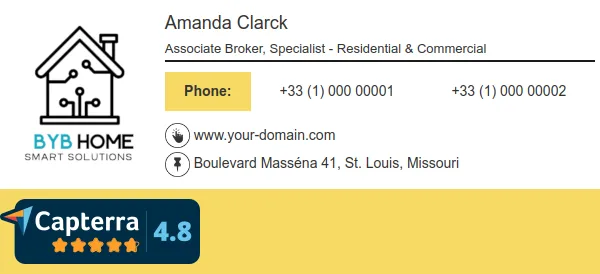
Your subject line has the perfect hook.
Your copy is short and punchy—your CTA shines.
In sum, you’ve nailed all 25 sales email tips, and you're ready to press send.
Not so fast.
Many salespeople spend so much time focusing on the subject line, copy, CTA, and other vital elements of the sales email that they forget about other details—like a professional email signature.
The best email signatures can serve as a digital business card with relevant, interesting information your prospect might need going forward. Or, it just helps you stand out—makes you memorable. Think it might be worth considering?
Disclaimer: We aren’t suggesting your response rate depends on your email signature's prowess. In some industries, and for some salespeople, in some contexts, perfecting a sales email signature might be a waste of time.
But today, we want to discuss this element of your emails: why it matters, what it includes, and some examples (essentially, email signature templates). Let’s get to it.
In addition to a polished email signature, leveraging the power of AI can take your email content to the next level. Our AI Email Writer tool helps you generate compelling email content that resonates with your audience, ensuring your message is both engaging and effective.
Why Does an Email Signature Matter in Sales?
A sales email signature is just what it sounds like—it’s what the salesperson signs off with at the end of their sales email. Like a digital business card, it often includes the name, title, company, and other relevant contact information of the sender.
But an effective email signature is more than a polite how-do-you-do. Instead, it has multiple benefits that make it an important finale to your killer sales email.
Build Trust
This is particularly relevant for cold email outreach, where your lead doesn’t know you from Adam. An email signature will help clear up the confusion.
When you add your role, contact information, and maybe even your LinkedIn profile, it does more than suggest your accessibility. It displays your competence. You aren’t the no-name, no-face salesperson #36—you’ve got credibility and an identity.
They know who you are, and what you do. The business relationship can grow from here.
Share Resources
Your email signature will likely include at least one link. The obvious choices are linking to your company website or social media profiles, but you can also lead the recipient in other directions, depending on what you want from them.
Do you prioritize one-to-one chats with prospects? Add your Calendly link. Is stellar content marketing one of the main ways you get customers hooked on your product? Include a CTA to your blog, YouTube channel, or whatever platform you use.
You might even link to reviews from your customers—if you want to boost your social proof.
As with most areas of sales, you want to provide value for your prospect, even with your email signature. What that value is—and how it’s presented—depends on your industry, where the prospect is in the pipeline, and your priorities (we’ll talk about this more in a minute.)
Ready to embrace AI's power for 10X content marketing? Explore our article.
Establish Authority + Brand Awareness
In cold outreach, this email is your first impression. And in follow-up outreach, you want to build upon that first impression, don’t you? Your email signature can help here.
Akin to building trust, an effective sales email signature establishes authority (both yours and the company’s) and elevates brand awareness. How do you want to present your logo? Is there a blog or video link that might be both currently relevant to your lead—and reflect super well on your company?
For you and your team, maybe it goes beyond basic info and a social link. What is your company’s brand story or value proposition? Are either of those worth including in a concise, creative way? A carefully-crafted email signature can become a marketing piece as well.
Maintaining trust and authority often requires consistency. So, consider a template for a uniform team-wide signature. This lets you develop one solid email signature—and keeping it consistent across your sales team creates brand recognition for the prospect, regardless of who they’re contacting on your team.
Are you unsure about email cadence for follow-ups in sales? Learn how to strike the right balance with our expert recommendations in our guide to technical email setup.
What Should a Sales Email Signature Include?
Your email signature should include only the information that matters to your prospects. Some of that information, like your name and title, is a no-brainer for every situation. Other information is more nuanced—it only matters to prospects in certain contexts.
Different industries and stages of the sales funnel could require different information and presentation from the sales email signature.
The bones of a classic sales email signature, however, are these:
- Name
- Title + Company
- Contact info
- CTA
- Social media
Nick Persico, Close’s Director of Sales & Marketing, shared his own take on sales email signatures: “Just put your name, title, and link to the URL you want folks to click on. Less is more. Fancy stuff may hurt your chances of landing in the inbox."
Keep this advice in mind as we take a closer look.
Basic Details + Contact Information
Your name. Your job title. Your company name. So far, so good.
Contact information could include your phone number, but avoid re-listing your email address if it’s the same one you’re using to contact them. A physical address may or not make sense, depending on your business structure and points of customer contact.
Some might qualify a headshot as basic information–and it can add a personal touch. Putting a face to a name can go a long way in building trust and credibility. This is particularly true if you are the owner of the business, or in a customer-facing position like sales. If you choose to include one, it must be professional and reflect your brand.
Alternatively, featuring your company logo can have a similar effect of aligning customers with the brand. Consider what might be best for you, test it out, and run with it.
Call to Action
Sometimes, your contact information is your CTA—all you want is for them to reach out. If that’s the case, make sure you direct them toward your preferred method (if you have a preference).
If you want them to schedule a 1:1 meeting for a chat, include your calendar link.
Cold leads might need more information before deciding to respond. Add your demo link. Further along in the pipeline, or prefer just diving in from the start? Add your trial link.
Or, maybe you prefer the educational route—you want to share valuable content with your reader. Include a link to a recent blog article, or a webinar with your founder (or another expert.)
Whatever you add, make sure it matters to your prospect. Don’t add a CTA just because you think it’s cool. Sometimes, short and sweet really takes the cake.
Social Media
Social media is an element of social proof—and it’s a way to better introduce yourself. With cold emails especially, it’s nice to have some easily-accessible background information on the sender. With existing customers, expanding your business relationship onto LinkedIn can benefit you both.
So, what platforms should you include? It really comes down to what marketing channels work best for you and your company. Depending on where you have a big presence, you might include links to:
- YouTube
Analyze these channels’ performance in the long run and reduce the links in your signature. Only those that generate engagement should stay.
And a word of warning: Don’t include more than two or three at a time. You may have great accounts on all these platforms, but don’t overburden your signature. You’ll soon learn why.
7 Examples of Sales Email Signatures (and Why They Work)
Different strokes for different folks. Or rather, different email signatures for different industries, brands, or even stages of the sales funnel.
To keep your business email signature fresh, consider using a free email signature generator like WiseStamp (or many others). These tools make it easy to update your signature regularly, and keep your sign-off looking sharp. At a minimum, a generator can serve as inspiration for your own creation.
Now, let’s look at those examples—when to use them, and why they work.
The Multi-Purpose Classic
Clean, informational, gets-the-job-done. Classic is a classic for a reason.
When in doubt, opt for an email signature that covers all your bases. You’ve got contact information, a timeless CTA, social media icons, and a nice headshot to establish your personality.
Here’s an example from Jessica Reed:
 |
Or, go even simpler. Here’s inspo from our own team at Close:
 |
When you don’t want to think too hard about updating your signature or getting too creative, or simplicity just fits your brand and audience best, go for something like this. It will work throughout the sales pipeline without issues.
Clean Call to Action
Less can be more, remember? Check out these examples. Some of the contact information we listed above is missing, but look at that CTA!
The name, title, and company are present—but the call to action is like a flashing arrow.
This type of signature probably shouldn’t go out with a cold email, as it doesn’t provide enough contact information (or context on who you are). And if your role relies heavily on customer contact, just use this format as inspo and adapt it to your needs.
 |
With follow-up emails, however, once the business relationship and trust have been established, this format can be super effective in getting your prospect to do what you want—namely, follow that CTA.
Remember how many options you have with an email signature CTA: demo, trial, blog link, advertising a sale, and so on. If the CTA is your purpose, hold to it with this style.
 |
Schedule a Chat
These examples also have clear calls to action, but the entire signature has a singular motive: getting in contact. Accessibility is key in sales, and depending on your role, it might become the primary focus of your email signature.
As you can see, multiple contact opportunities are listed along with the CTA—which is a link to the calendar.
 |
The information is presented clearly. Notice that each example is relatively clean, opting for a logo instead of a headshot. What stands out is the calendar—as intended. It’s cohesive and well-branded.
This can be used throughout the sales funnel, depending on your approach and intentions with the prospect (and, as mentioned above, your role).
 |
Brand Awareness
This type of email signature works especially well for cold emails. That’s because your lead is learning about your company from the ground up—providing context and additional information here can help establish your brand.
By the way, our AI-based cold email generator tool is the perfect solution for streamlining your outreach efforts.
Notice that this signature provides a nice balance of information, both contact and background. The logo and color palate assist with branding, and the reviews demonstrate social proof with minimal effort.
 |
For some industries, like real estate, robust, eye-catching email signatures are more common. There are, of course, more streamlined ways to incorporate branding into your email signature—play around and see what works.
Now that we have some fresh ideas, let’s make sure we don’t commit any of the sales email signature sins as we move forward in the design.
Curious about the secrets to successful B2B cold emails? Check out our article on 12 B2B Cold Email Templates and discover the art of crafting a persuasive b2b cold email template.
6 Sales Email Signature Mistakes to Avoid
Your sales team—and sales emails—are fallible. To avoid turning off potential customers with just your email signature (an unfortunate shooting-yourself-in-the-foot situation, if there ever was one), follow these basic rules of thumb and leave these out of your signature.
Including Large Images
When you include large images, or just attach too many, your email will take too long to load. Besides frustrating the recipient, this often impacts deliverability as it is caught by spam filters.
This becomes extra important if you choose to include a headshot or banner. While different spam filters have different criteria for the balance between text and graphics, you should aim for an 80:20 text-to-image ratio throughout your email, just to be safe. You want this thing delivered, right?
For the same reason, you should avoid adding oversized GIF logos (or, in most situations, any GIF at all.)
Making It Too Long
This isn’t the time or place to cram in a bunch of info.
Your sales email signature needs to be clear and actionable. This means it should have a relevant point like every other area of your sales email, and not leave people bored, confused, or (at worst) fed up with you.
If they want to contact you—it should be clear how they do that. To connect on social media? Again, clear. No “four different phone numbers” or ten lines of text.
Be intentional about what you choose to include. Don’t ramble. Get in, get out, and leave your intended impression—with only the contact and other information relevant to this interaction.
Adding Unnecessary Information
Fax number, anyone? How about repeating the email address that you’re already emailing them from?
You don’t need to add all three of your phone numbers—or include all five of your social media profiles. This bogs down your message. Don’t include HTML or spammy links either—these can impact deliverability.
As mentioned earlier, you need to consider the sales-prospect relationship and positioning in the pipeline to determine what info is most necessary to include.
With the Close CRM, you can use Workflows to tailor and automate your messaging, depending on your prospect’s location in the pipeline. This streamlines your follow-up outreach…and you can adjust your email signature for each template, based on relevant context.
 |
Using an Image-Only Signature
Sure, sometimes an image is too large and gets blocked.
Other times, email platforms block all images (more common if you’re an unknown sender). Your sales email signature will survive without your logo image or short banner, but don’t let the spam filter swallow everything.
Even if you dodge the filter, image-only signatures might have display issues depending on the inbox. Be aware of that and stick to text, when possible.
Having Too Much of Everything
This is a blanket warning: You don’t want an email signature that looks like it was designed by a newbie to Canva, or a kindergartner who got into the craft drawer.
There is creative…and then, there is too creative. It might be smart to tailor your font and color to your company branding. What you don’t want to do is create chaos with changing fonts, unusual spacing, and half a color wheel. Again, less is more. Let the rest of your email do the talking, and your signature sum up the message.
Not Testing Your Signature For Multiple Email Clients
Your signature might appear differently in a Gmail inbox versus an Outlook one.
Besides the previously mentioned dangers of an image-only signature, you might face font, spacing, and other display issues. You want to ensure that any images—like a headshot or logo—translate correctly, too.
Test your signature(s) across all the most popular email platforms so that it arrives in your prospect’s inbox as intended. Also, be sure that you optimize for desktop, mobile devices, and other common screen sizes. Don’t trip on the last lap.
And speaking of testing, triple-check that there aren’t any typos in your signature. A solid, legitimate pitch won’t be signed by a wannabe scammer who misspells the company’s name.
Signing Off + Following Up
By now, you might have already dreamed up the mistake-free and effective signature that will close out your next amazing sales email.
So, what’s next? Now might be a good time to look closely at your follow-up email strategies. Powerful email marketing requires persistence and attention to detail—from subject line to signature, cold outreach to follow-up. The follow-up is key to the sale, so make it count.
As you make decisions about your email signature (and whether to adapt it for the follow-up), remember to create value for the customer—and only give prospects the information that really matters to them.
Best of luck!
Email open rates down? Your email subject line might be the culprit. Our email subject line generator can help craft the perfect subject line. Did we mention its free? Give it a spin.










